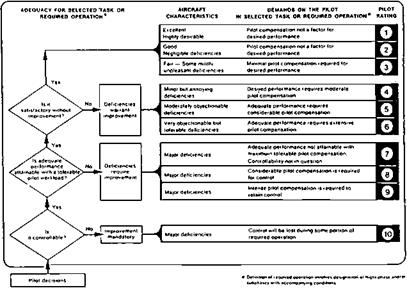Equivalent System Models and Pilot Rating
The 1980 military flying qualities specification MIL-F-8785C represents the culmination of the representation of airplanes by classical transfer functions (see 20.4), the transfer functions of bare airframes augmented only by simple artificial damping and crossfeeds, where needed. In pitch, the bare airframe transfer function of pitching velocity as an output to control surface angle as an input has an inverse second-order denominator and a first-order numerator under the constant airspeed assumption. Three parameters define this function: natural frequency and damping ratio in the denominator and the numerator time constant. The classical bare-airframe transfer function models are called equivalent systems because they can only approximate the transfer functions of complex, augmented flight control systems, such as command augmentation systems and the newer superaug – mented systems for highly unstable airframes. The uses to which equivalent system models are put in specifying longitudinal and lateral flying qualities are illustrated in Chapter 10, “Tactical Airplane Maneuverability.”
The 1980 specification MIL-F-8785C represented another culmination in the development of airplane flying qualities as a science. This is assigning a numerical scale to pilot opinion. In the 1950s A. G. Barnes in the United Kingdom used the initials G, M, and B for good, medium, and bad, with + and — modifiers. The numerical scale, running from 1 to 10, was proposed by George E. Cooper in 1961. The MIL-F-8785C uses the Cooper-Harper rating scale (Figure 3.11), in which the experience of NASA and Calspan are combined (Cooper and Harper, 1969).
A successor to the Cooper-Harper rating scale originated at the College of Aeronautics, Cranfield University (Harris et al., 2000) to deal better with modern fly-by-wire aircraft. The proposed new scale, called the Cranfield Aircraft Handling Qualities Rating Scale, or CAHQRS, considers separately five parameters – longitudinal, lateral, directional, trim, and speed control – and rates behavior in subtasks according to a Cooper-Harper-type scale, and also a criticality scale. The CAHQRS has been tested initially on a flight simulator. Further
|
Figure 3.11 The Cooper-Harper pilot numerical rating scale, now a definitive standard. (From NASA TN D-5153, 1969) |
experience with this new approach is needed to confirm its expected benefits relative to the Cooper-Harper standard.
The next phase in the unfolding history of the science of flying qualities involves a new level of sophistication, freeing the subject from the constraint of equivalent systems. Mathematical models of the human pilot as a sort of machine are combined with airplane and control system mathematical models and are treated as a combined system. Human physiology and psychology are now enlisted in the study of flying qualities requirements. These interesting developments are treated in Chapter 21, “Flying Qualities Research Moves With the Times.”














